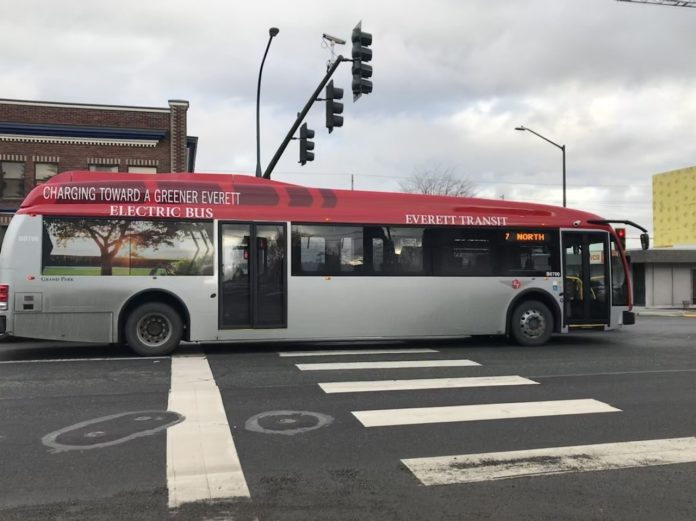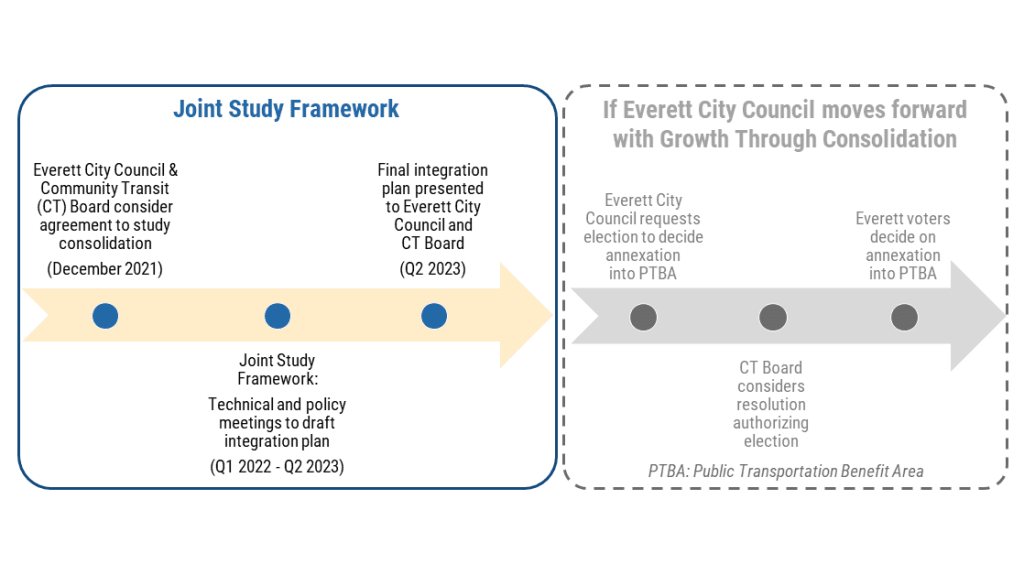Everett Transit and Community Transit are moving forward with merger planning, following direction from the Everett City Council this summer. If realized, the merger would expand Community Transit’s service area to cover all of Everett and largely bring existing Everett Transit staff into the agency’s fold. The merger would offer riders seamless service across jurisdictional boundaries with one-seat rides and a much higher level of frequency in Everett, but could mean increasing the transit sales tax in Everett from 0.6% to 1.2% to reach parity with Community Transit’s sales tax elsewhere in Snohomish County. Without the merger, Everett’s transit service is likely to remain disjointed and anemic.
Both agencies’ managing boards have approved a framework to conduct a joint study on consolidation of services. The study is expected to take about a year-and-a-half to complete and cost $96,800 (a cost to be shared equally by the parties). According to the conceptual timeline, work on an integration plan would begin in earnest early next year. A final integration plan could be delivered by the second quarter of 2023 to the respective managing boards for consideration.
The agreed upon framework outlines several specific objectives in developing an integration plan:
- “Define the mechanism for implementation and identify the path to a ballot measure for voter consideration.”
- “Clearly describe the type, extent, and delivery model of transit services that would be offered under Growth Through Consolidation option.”
- “Define the transfer of facilities, vehicles, and equipment.”
- “Consider governance implications and options for Board representation and reach agreement on preferred approach.”
- “Evaluate options and timing of transition, including potential phasing, and its financial, service, customer, and community impacts.”
- “Describe the transition and integration of workforce and all supporting functions.”
- “Develop a joint communication, marketing, and brand strategy.”
- “Determine the need for and clearly define any policy changes required by the mutually agreed consolidation plan.”
Some other big issues that the integration plan will need to address are fare structures and labor union protections.
Underpinning the entire effort will be shared ownership and commitment by both agencies at every step and every work product. Partnership is a strong philosophy that the agencies hope to carry forward as understandably difficult conversations advance.
Structurally, the framework calls for three advisory and decision-making bodies to inform development of the integration. The bodies will include a Technical Working Group, Executive Advisory Group, and a Joint Policy Committee. A third-party independent facilitator will also be hired to assist in decision-making.
Most of the key production work will happen with the Technical Working Group, led by agency staff and other subject matter experts. According to the framework, the group will be tasked with determining what should be addressed by the integration plan, collect data and conduct analysis, evaluate alternatives, and develop recommendations. For the recommendations themselves, those will be determined by consensus.
The Executive Advisory Group, for its part, will be the next level up and consist of senior and executive agency staff as well as Everett’s deputy mayor. The group will provide guidance to the Technical Working Group and support the Joint Policy Committee. Above the group will be the Joint Policy Committee, which will focus on representing residents of Everett and the Community Transit service area in developing an integration plan. Members of the committee will be two Everett city councilmembers, three Community Transit boardmembers, and the mayor of Everett. Ultimately, the committee will need to reach consensus in making recommendations on and approving a final integration plan that is in the best of interest of all community members.
Once a final integration plan is adopted, it will be up to Everett’s mayor and the city council to decide how to move forward. That could mean adopting legislation to proceed with a ballot measure authorizing annexation into the Community Transit service area and all that entails (e.g., transfer of equipment, changes in taxation, and merging staff).
Based upon anticipated completion of the final integration, there is some flexibility in when a ballot measure could proceed. The earliest is the August primary or November general election in 2023, but odd-year elections tend to be lower turnout events and overrepresented by more conservative voters. Waiting until the 2024 presidential election, when turnout is projected to be higher, could be more representative of voter desires, but given the truly dire status of Everett Transit there arguably should be some urgency in securing consolidation and service improvements sooner rather than later.
In the months and year or so ahead, we should get a sense of what a consolidated network might look like with service levels, connections, and corridors. To the average person, that’s probably what will be of most interest, answering key questions of whether or not the consolidated system would be better than it is today and offer more value to the communities it serves.
Stephen is a professional urban planner in Puget Sound with a passion for sustainable, livable, and diverse cities. He is especially interested in how policies, regulations, and programs can promote positive outcomes for communities. With stints in great cities like Bellingham and Cork, Stephen currently lives in Seattle. He primarily covers land use and transportation issues and has been with The Urbanist since 2014.




